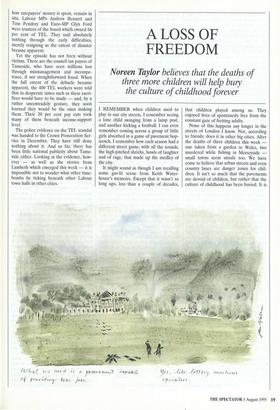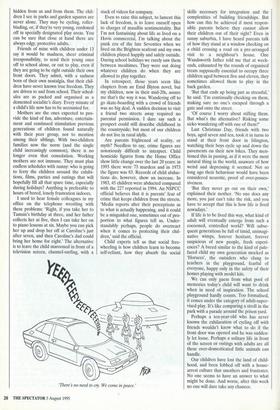A LOSS OF FREEDOM
Noreen Taylor believes that the deaths of
three more children will help bury the culture of childhood forever
I REMEMBER when children used to play in our city streets. I remember seeing a lone child swinging from a lamp post, and another kicking a football. I can even remember coming across a group of little girls absorbed in a game of pavement hop- scotch. I remember how each season had a different street game, with all the sounds, the high-pitched shrieks, howls of laughter and of rage, that made up the medley of the city.
It might sound as though I am recalling some gas-lit scene from Keith Water- house's memoirs. Except that it wasn't so long ago, less than a couple of decades, that children played among us. They enjoyed lives of spontaneity free from the constant gaze of fretting adults.
None of this happens any longer in the streets of London I know. Nor, according to friends, does it in other big cities. After the deaths of three children this week — one taken from a garden in Wales, two murdered while fishing in Merseyside — small towns seem unsafe too. We have come to believe that urban streets and even country lanes are danger zones for chil- dren. It isn't so much that the pavements are devoid of children, but rather that the culture of childhood has been buried. It is hidden from us and from them. The chil- dren I see in parks and garden squares are never alone. They may be cycling, roller- blading, or, if they're very young, cordoned off in specially designated play areas. You can be sure that close at hand there are always edgy, protective adults.
Friends of mine with children under 13 say it would be madness, sheer criminal irresponsibility, to send their young ones off to school alone, or out to play, even if they are going to be right outside their own front doors. They admit, with a sadness born of their own nostalgia, that their chil- dren have never known true freedom. They are driven to and from school. Their sched- ules are as packed and organised as a demented socialite's diary. Every minute of a child's life now has to be accounted for.
Mothers are the ones expected to pro- vide the kind of fun, adventure, entertain- ment and continued stimulation previous generations of children found naturally with their peer group, not to mention among their siblings. With two-children families now the norm (and the single child increasingly common), there is no longer even that consolation. Working mothers are not immune. They must plan endless schedules with nanny: who is going to ferry the children around the exhibi- tions, films, parties and outings that will hopefully fill all that spare time, especially during holidays? Anything is preferable to hours of bored, lonely frustration indoors.
I used to hear female colleagues in my office on the telephone wrestling with these problems: 'Right, if you take her to Tamsin's birthday at three, and her father collects her at five, then I can take her on to piano lessons at six. Maybe you can pick her up and drop her off at Caroline's just after seven, and then Caroline's dad could bring her home for eight.' The alternative is to leave the child marooned in front of a television screen, channel-surfing, with a stack of videos for company.
Even to raise this subject, to lament this lack of freedom, is to leave oneself open to charges of maudlin sentimentality. But I'm not fantasising about life as lived on a Hovis commercial, I'm talking about the punk era of the late Seventies when we lived on the Brighton seafront and my own children played happily and safely outside. During school holidays we rarely saw them between mealtimes. They were out doing whatever children do when they are allowed to play together.
In retrospect, those years seem like chapters from an Enid Blyton novel, but my children, now in their mid-20s, assure me that's the way it was. Wandering off to go skate-boarding with a crowd of friends was no big deal. A sudden decision to visit a friend two streets away required no parental permission. I dare say such a prospect could still describe childhood in the countryside; but most of our children do not live in rural idylls.
Are parents frightened of reality, or myth? Needless to say, crime figures are notoriously difficult to interpret. Child homicide figures from the Home Office show little change over the last 20 years: in 1993 there were 73 murders and in 1973 the figure was 83. Records of child abduc- tions do, however, show an increase. In 1983, 45 children were abducted compared with the 227 reported in 1994. An NSPCC official believes that it is parents' fear of crime that keeps children from the streets. 'Media reports alter their perceptions as to what is actually happening, and it could be a misguided one, sometimes out of pro- portion to what figures tell us. Under- standably perhaps, people do overreact when it comes to protecting their chil- dren,' said the official.
Child experts tell us that social free- wheeling is how children learn to become self-reliant, how they absorb the social 'There's no no need to cry. We come in peace.' skills necessary for integration and the complexities of building friendships. But how can this be achieved if most respon- sible parents believe they cannot allow their children out of their sight? Even in sunny suburbia, I have heard parents talk of how they stand at a window checking on a child crossing a road on a pre-arranged visit to a neighbour's house. One Wandsworth father told me that at week- ends, exhausted by the rounds of organised treats supposedly essential to occupy three children aged between five and eleven, they sometimes allowed them to play in the back garden.
'But that ends up being just as stressful,' he said. `I'm continually checking on them, making sure no one's escaped through a gate and onto the street.
'Of course I worry about stifling them. But what's the alternative? Risking some sicko wandering off with one of them?'
Last Christmas Day, friends with two boys, aged seven and ten, took it in turns to stand at their front door in Islington, watching their boys cycle up and down the pavements on their new bikes. They men- tioned this in passing, as if it were the most natural thing in the world, unaware of how weird and depressing it seemed. Not so long ago their behaviour would have been considered neurotic, proof of over-posses- siveness.
'But they never go out on their own,' explained their mother. 'No one does any more, you just can't take the risk, and you have to accept that this is how life is lived nowadays.'
If life is to be lived this way, what kind of adult will eventually emerge from such a cocooned, controlled world? Will subse- quent generations be full of timid, unimagi- native wimps, forever hesitant, forever suspicious of new people, fresh experi- ences? A breed similar to the kind of pale- faced child my own generation mocked as 'Horaces', the outsiders who clung to teachers in the playground, fearful of everyone, happy only in the safety of their homes playing with model kits.
We can only guess from what pool of memories today's child will want to drink when in need of inspiration. The school playground hardly counts. Too formalised, it comes under the category of adult-super- vised play. It's like comparing a stroll in the park with a parade around the prison yard.
Perhaps a ten-year-old who has never known the exhilaration of cycling off with friends wouldn't know what to do if the front door was opened and he was sudden- ly let loose. Perhaps a solitary life in front of the screen or outings with adults are all these over-domesticated little animals can handle.
Our children have lost the land of child- hood, and been fobbed off with a house- arrest culture that smothers and frustrates. No one seems to have an answer to what might be done. And worse, after this week no one will dare take any chances.



















































 Previous page
Previous page